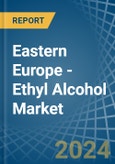Product coverage:
- Prodcom 20147400 - Undenatured ethyl alcohol of an alcoholic strength by volume. .80 % (important: excluding alcohol duty)
- Prodcom 20147500 - Denatured ethyl alcohol and other denatured spirits, of any strength
This report provides an in-depth analysis of the ethanol market in Eastern Europe. Within it, you will discover the latest data on market trends and opportunities by country, consumption, production and price developments, as well as the global trade (imports and exports). The forecast exhibits the market prospects through 2025.
Country coverage:
- Belarus
Data coverage:
- Market volume and value
- Per Capita consumption
- Forecast of the market dynamics in the medium term
- Production in Eastern Europe, split by region and country
- Trade (exports and imports) in Eastern Europe
- Export and import prices
- Market trends, drivers and restraints
- Key market players and their profiles
Reasons to buy this report:
- Take advantage of the latest data
- Find deeper insights into current market developments
- Discover vital success factors affecting the market
This report is designed for manufacturers, distributors, importers, and wholesalers, as well as for investors, consultants and advisors.
In this report, you can find information that helps you to make informed decisions on the following issues:
- How to diversify your business and benefit from new market opportunities
- How to load your idle production capacity
- How to boost your sales on overseas markets
- How to increase your profit margins
- How to make your supply chain more sustainable
- How to reduce your production and supply chain costs
- How to outsource production to other countries
- How to prepare your business for global expansion
While doing this research, the researchers combined the accumulated expertise of their analysts and the capabilities of artificial intelligence. The AI-based platform, developed by data scientists, constitutes the key working tool for business analysts, empowering them to discover deep insights and ideas from the marketing data.
Table of Contents
Methodology

LOADING...








